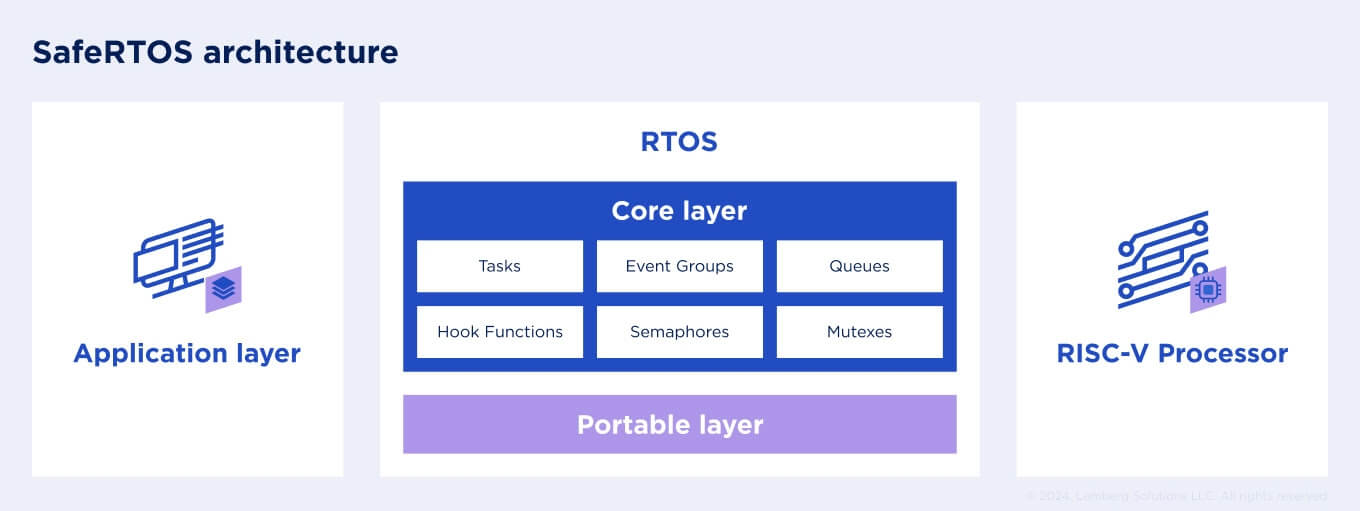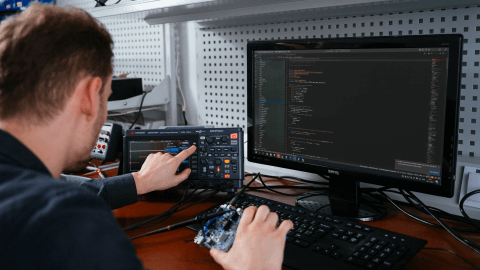Real-time systems have become inevitable in technology applications where functional safety and reliability define safety for future users. This has led to the need to create a specifically designed real-time operating system, SafeRTOS, that adheres to safety standards and is suitable for safety-critical embedded software systems.
Our article explores SafeRTOS functionality and capabilities more deeply, outlining its core features, supported safety certifications, benefits, and applications in multiple domains.
What is SafeRTOS?
SafeRTOS is a real-time operating system based on FreeRTOS, created by the Wittenstein company, whose original purpose was to provide a working platform for embedded systems where safety takes the highest priority.
Due to compliance with industry safety standards and functionality integrity, SafeRTOS is primarily used for medical, automotive, and industrial embedded software development. It is pre-certified to IEC 61508 and ISO 26262 ASIL D while supporting other international safety and engineering standards, meaning you don't have to certify your product individually.
Key features of SafeRTOS
SafeRTOS requires minimal resources and ensures high performance of embedded systems, which is crucial for complex solutions with vast functionality. In the image below, you can see a detailed overview of the SafeRTOS architecture.

As previously mentioned, learning more about SafeRTOS core features will help us discover why it is popular for embedded software development in specific industries.
Deterministic priority scheduling
The deterministic scheduling nature of safety-certified RTOS allows us to set up time frames accurately to execute critical tasks. It makes embedded system operation predictable, stable, and reliable, which is paramount for medical devices or vehicle control systems.
Real-time capabilities
Wittenstein SafeRTOS can provide continuous real-time monitoring, ensuring immediate response to system changes. For instance, if a signal of a specific sensor fades, RTOS reacts immediately to this by increasing the PWM signal frequency. This option is especially critical for medical solutions to ensure round-the-clock monitoring of patient's health vitals and prevent their deterioration.
Memory protection
SafeRTOS embedded platform isolates memory within a system, which has several benefits. First, it guarantees the protection of sensitive data by banning unauthorized access. Also, memory protection doesn't allow overwriting the memory space of one task to another and prevents application failure for safety-critical embedded solutions.
Safety features
SafeRTOS is a pre-certified platform for ISO 26262 ASIL D, the highest functional safety standard in the automotive industry. It also supports the safety design standards for the industrial (IEC 61508), aerospace (DO-178C), and healthcare (IEC 62304/FDA 510(k)) domains. Such embedded products can be easily certified and used for their purpose in the respective industry, ensuring a desired level of safety and performance.
Read also: Choosing the Right RTOS for Your Embedded System

Which certifications does SafeRTOS support?
Safe RTOS provides exhaustive technical documentation and functionality that allow embedded engineers to meet ISO 26262, DO-178C, and IEC 61508 standards in the development process. Below, you can find more details on each compliance and how it enhances embedded system safety:

- IEC 61508 SIL 3 — a core functional safety standard used for safety-critical system development in multiple industries. SIL 3 provides high safety integrity and analysis, validation techniques, and helps predict and reduce risks.
- ISO 26262 — an international functional safety standard used for electrical and electronic road vehicle system development and helps reach the highest critical safety requirements, predict hazards, and reduce risks in automotive software solutions.
- DO-178C — a global-wide safety standard used for safety-critical software development for airborne equipment, ensuring peak system reliability.
Benefits of using SafeRTOS
What other benefits does SafeRTOS provide for your embedded system development and high performance and safety certification? Keep reading, as we have covered them below.

Easier certification
SafeRTOS includes a Design Assurance Pack (DAP) required for correct SafeRTOS installation and integration in the system following the Safety Manual. It provides a step-by-step engineering process guide, including planning, design, and verification options based on the chosen compiler.
Complying with this process, you ensure your SafeRTOS-based solution will be certified and allowed to be used more easily and quickly in your domain.
Enhanced safety and security
RTOS is a critical component for embedded systems used for safety-critical purposes. It is responsible for scheduling and operating the system safety monitors and integrated safety functions.
Ease of integration
As SafeRTOS is based on FreeRTOS functionality and capabilities, the migration process from FreeRTOS to SafeRTOS will be smooth, following the manufacturer's specifically made guidelines and instructions.
Top use cases of SAFERTOS
SafeRTOS is widely used in automotive, medical device, and industrial applications. Let's examine how SafeRTOS benefits embedded software development in these domains.
Automotive software systems
Functional safety is the utmost priority in automotive software development for vehicle control systems. The final version must verify a safe driving experience for vehicle drivers and other road users, with previously assessed risks and analyzed hazards.
Since SafeRTOS conforms with the software design requirements set by ISO 26262 ASIL C and D levels, it is a great choice for automotive software development. The SafeRTOS platform includes a full RTOS package for automotive software engineering, including SAFECheckpoints and OSEK AS adaptation layer.
Medical device software
To be certified, a medical device must comply with a range of safety requirements and industry standards, such as ISO 13485, IEC 60601, and IEC 62304, among others. Following all the requirements guarantees your medical device can be used for patient treatment, such as remote patient monitoring, precision drug dosage, or vital signs recording.
Industrial device software
Owing to its compatibility with IEC 61508, SafeRTOS is also a good fit for industrial automation software development. Its functionality effectively copes with complex processes and tasks and provides risk assessment and prediction to ensure device reliability and serviceability in critical cases.
Which RTOS should you choose: SafeRTOS vs FreeRTOS?
The SafeRTOS kernel is based on FreeRTOS but is not its exact copy in terms of functionality and uses. It was fundamentally remade to comply with high safety industry requirements and the IEC 61508-3 SIL 3 development life cycle.
If you need your device to adhere to specific standards, SafeRTOS is a suitable choice. If you have no specific requirements for your product, you can choose FreeRTOS, which doesn't require additional fees compared to SafeRTOS. Also, FreeRTOS is easier to use and provides higher speed as it has no integrated safety functionality, and tests are critically required for SafeRTOS.
Summing up
Which RTOS you should opt for your embedded software development primarily depends on the industry, type of project, available high-level requirements, and other specific features related to your solution.
Feel free to contact our expert embedded engineers so you can share your embedded project requirements and receive a development plan, including tech stack selection and a detailed estimation.





